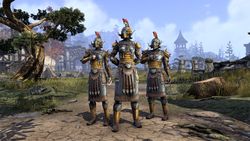| Akaviri Potentate | |||
|---|---|---|---|
 Akaviri Potentate armor |
|||
| 2E 1 – 2E 430 | |||
| Capital | Imperial City | ||
| Location | Cyrodiil | ||
| Common languages | Cyrodilic | ||
| Religions | |||
| Government | Absolute monarchy | ||
| Preceded By | Succeeded By | ||
|
|
|
||
The Akaviri Potentate[1] (also called the Akaviri Empire[2] or the Akaviri Dynasty),[3] additionally known as the Colovian Emperor-Potentate or the Colovian Dynasty[4][nb 1] was the period of the Second Empire after the assassination of Reman III and the end of the Reman Dynasty. Prior to this period, potentate was the title of the chief advisor of the Reman Emperors.[1][5]
HistoryEdit
First EraEdit
In the battle of Pale Pass, Reman I decisively defeated an Akaviri invasion but other events forced him to offer the defeated army amnesty in return for their service in his own army. This led to Akaviri influence in other spheres of life, and over time the position of Potentate was usually filled by one of the snake people.[1]
In the year 1E 2920, Potentate Versidue-Shaie plotted to assassinate Emperor Reman III. He assassinated Reman III shortly after the death of Crown Prince Juilek, and declared Reman's line to be extinct. On 22 Evening Star, 1E 2920, Versidue-Shaie declared that he was taking over the leadership of the empire but retaining his title of Potentate. In the same speech, he declared the end of the First Era and the start of the Second.[6]
Second EraEdit
In order to suppress armies remaining loyal to the Remans, as well as the armies belonging to individual kingdoms seeking greater autonomy, Versidue-Shaie was forced to engage in a relentless series of campaigns that, by the year 2E 283, finally resulted in victory for his forces.[7] This suppression of those loyal to the Remans may have been the "Reman purges", where the Potentates invented contraptions for cutting off heads.[8] The cost of the campaigns was immense, resulting in the impoverishment of both the empire and its constituent kingdoms and in an effort to maintain order without the expense of a standing army, in 2E 321 Versidue-Shaie agreed to a proposal from his kinsman Dinieras-Ves that established what was to become known as the Fighters Guild.[9]
In 2E 324, Versidue-Shaie was assassinated by the Morag Tong[4][10] and succeeded by his son, Savirien-Chorak. In 2E 400 Savirien-Chorak held a celebration to commemorate four centuries of potentate rule.[11] In turn, he was assassinated along with all his heirs on one night in Sun's Dawn 2E 430, bringing a final end to the Second Empire and signaling the start of the Interregnum.[4]
PotentatesEdit
| Name | Born | Race | Beginning of Reign | Died, Deposed, Abdicated, or Office Abolished |
Additional Information |
|---|---|---|---|---|---|
| Second Empire — Akaviri Potentate | |||||
| Versidue-Shaie | 1E ? | Tsaesci | 1E 2920[6][12] | 2E 324[13][14] | Upon assuming leadership of the Empire, Versidue-Shaie declared the beginning of the Second Era. Assassinated by the Morag Tong.[13] |
| Savirien-Chorak | 1E ? | Tsaesci | 2E 324[7] | 2E 430[15][13][nb 2] | Son of Versidue-Shaie. Assassinated by the Dark Brotherhood.[13][nb 3] |
NotesEdit
- Sidri-Ashak was an obscure and lesser known potentate. He is perhaps best known for five runestones dotted across the Imperial province that bear his name. He advised Emperor Brazollus Dor, who ruled between the reigns of Reman II and Reman III. Neither interested nor skilled in matters of state, Emperor Dor left most of the governing to him, and he proved to be a capable statesman.[5]
- The Akaviri Potentate's peculiar armorsmithing practices were said to have changed the Imperial Legion forever.[17]
- The Magnates of the town of Hakoshae in Elsweyr believed themselves to be descendants of the Potentates through Proconsul Beloren-Kaie,[18] but it was revealed in 2E 582 that they were in truth descended from Lein-Barduik, the bodyguard of the Proconsul, who had abandoned him to assassins and taken his identity.[19]
- The next Potentate to rule the Empire was Ocato of Firsthold, who assumed control of the Third Empire at the beginning of the Fourth Era after the Elder Council failed to appoint a new emperor.[20]
ReferencesEdit
- ^ a b c d e Pocket Guide to the Empire, 1st Edition: Cyrodiil — Imperial Geographical Society, 2E 864
- ^ Secrets of Amenos — Miramel Charascel, Chairperson of the Gonfalon Bay Historical and Social Society
- ^ a b The Brothers of Darkness — Pellarne Assi
- ^ a b c d e f The Brothers of Darkness — Pellarne Assi
- ^ a b High King Emeric Answers Your Questions — High King Emeric
- ^ a b 2920, Evening Star — Carlovac Townway
- ^ a b History of the Fighters Guild
- ^ Blackmarrow Harvester dialogue in ESO
- ^ Fighters Guild Charter
- ^ Fire and Darkness — Ynir Gorming
- ^ The Poet-Champion of Vastyr — Chanter Milius, Priest of Dibella
- ^ History of House Mornard — Dorothea Errard
- ^ a b c d The Brothers of Darkness — Pellarne Assi
- ^ Fire and Darkness — Ynir Gorming
- ^ Pocket Guide to the Empire, 3rd Edition: The Seat of Sundered Kings: Cyrodiil — Imperial Geographical Society, 3E 432
- ^ The Daggerfall Chronicles — Ronald Wartow
- ^ Serpent Strand item description in ESO
- ^ Letter to Feina-Darak
- ^ Proconsul Beloren-Kaie's dialogue in ESO: Elsweyr
- ^ Rising Threat — Lathenil of Sunhold
Note: The following references are considered to be unofficial sources. They are included to round off this article and may not be authoritative or conclusive.